Understanding Roles, Responsibilities in Training and Education
VerifiedAdded on 2022/12/28
|28
|10315
|1
Report
AI Summary
This report provides a comprehensive analysis of the roles, responsibilities, and relationships within education and training, specifically focusing on the role of a Spanish teacher for primary students. It delves into the importance of identifying and meeting individual learner needs, examining initial and diagnostic assessment methods, and exploring ways to adapt teaching plans for diverse learners. The report also covers various assessment types, methods, and their effectiveness in enhancing student learning, including communication mediums used in the classroom. Furthermore, it evaluates the effectiveness of different learning and teaching approaches, with a focus on planning, delivering, and assessing inclusive learning environments. The report also discusses relevant legislation, regulatory requirements, and codes of practice, highlighting how teachers can promote respect, equality, and value diversity in their practice.
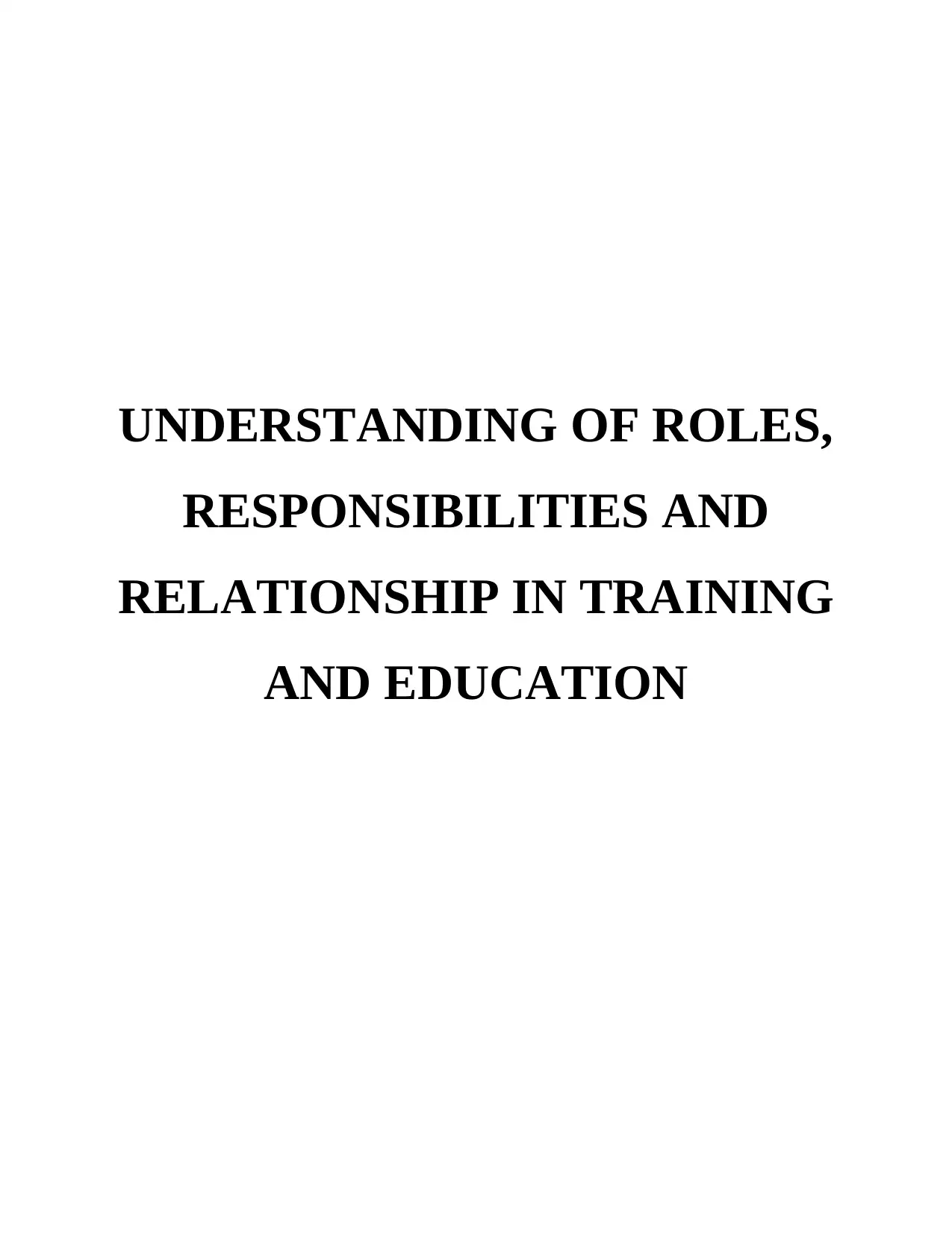
UNDERSTANDING OF ROLES,
RESPONSIBILITIES AND
RELATIONSHIP IN TRAINING
AND EDUCATION
RESPONSIBILITIES AND
RELATIONSHIP IN TRAINING
AND EDUCATION
Paraphrase This Document
Need a fresh take? Get an instant paraphrase of this document with our AI Paraphraser
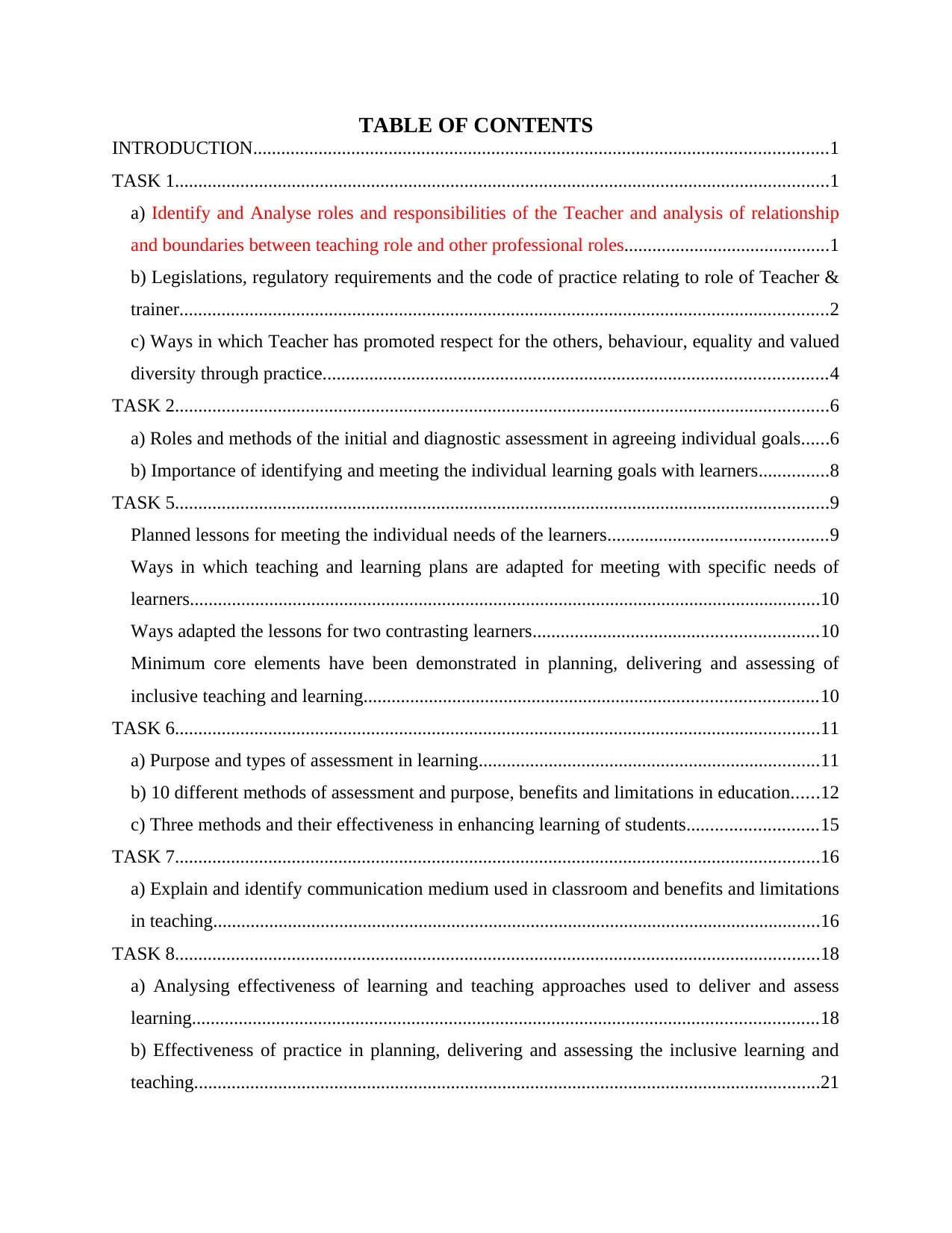
TABLE OF CONTENTS
INTRODUCTION...........................................................................................................................1
TASK 1............................................................................................................................................1
a) Identify and Analyse roles and responsibilities of the Teacher and analysis of relationship
and boundaries between teaching role and other professional roles............................................1
b) Legislations, regulatory requirements and the code of practice relating to role of Teacher &
trainer...........................................................................................................................................2
c) Ways in which Teacher has promoted respect for the others, behaviour, equality and valued
diversity through practice............................................................................................................4
TASK 2............................................................................................................................................6
a) Roles and methods of the initial and diagnostic assessment in agreeing individual goals......6
b) Importance of identifying and meeting the individual learning goals with learners...............8
TASK 5............................................................................................................................................9
Planned lessons for meeting the individual needs of the learners...............................................9
Ways in which teaching and learning plans are adapted for meeting with specific needs of
learners.......................................................................................................................................10
Ways adapted the lessons for two contrasting learners.............................................................10
Minimum core elements have been demonstrated in planning, delivering and assessing of
inclusive teaching and learning.................................................................................................10
TASK 6..........................................................................................................................................11
a) Purpose and types of assessment in learning.........................................................................11
b) 10 different methods of assessment and purpose, benefits and limitations in education......12
c) Three methods and their effectiveness in enhancing learning of students............................15
TASK 7..........................................................................................................................................16
a) Explain and identify communication medium used in classroom and benefits and limitations
in teaching..................................................................................................................................16
TASK 8..........................................................................................................................................18
a) Analysing effectiveness of learning and teaching approaches used to deliver and assess
learning......................................................................................................................................18
b) Effectiveness of practice in planning, delivering and assessing the inclusive learning and
teaching......................................................................................................................................21
INTRODUCTION...........................................................................................................................1
TASK 1............................................................................................................................................1
a) Identify and Analyse roles and responsibilities of the Teacher and analysis of relationship
and boundaries between teaching role and other professional roles............................................1
b) Legislations, regulatory requirements and the code of practice relating to role of Teacher &
trainer...........................................................................................................................................2
c) Ways in which Teacher has promoted respect for the others, behaviour, equality and valued
diversity through practice............................................................................................................4
TASK 2............................................................................................................................................6
a) Roles and methods of the initial and diagnostic assessment in agreeing individual goals......6
b) Importance of identifying and meeting the individual learning goals with learners...............8
TASK 5............................................................................................................................................9
Planned lessons for meeting the individual needs of the learners...............................................9
Ways in which teaching and learning plans are adapted for meeting with specific needs of
learners.......................................................................................................................................10
Ways adapted the lessons for two contrasting learners.............................................................10
Minimum core elements have been demonstrated in planning, delivering and assessing of
inclusive teaching and learning.................................................................................................10
TASK 6..........................................................................................................................................11
a) Purpose and types of assessment in learning.........................................................................11
b) 10 different methods of assessment and purpose, benefits and limitations in education......12
c) Three methods and their effectiveness in enhancing learning of students............................15
TASK 7..........................................................................................................................................16
a) Explain and identify communication medium used in classroom and benefits and limitations
in teaching..................................................................................................................................16
TASK 8..........................................................................................................................................18
a) Analysing effectiveness of learning and teaching approaches used to deliver and assess
learning......................................................................................................................................18
b) Effectiveness of practice in planning, delivering and assessing the inclusive learning and
teaching......................................................................................................................................21
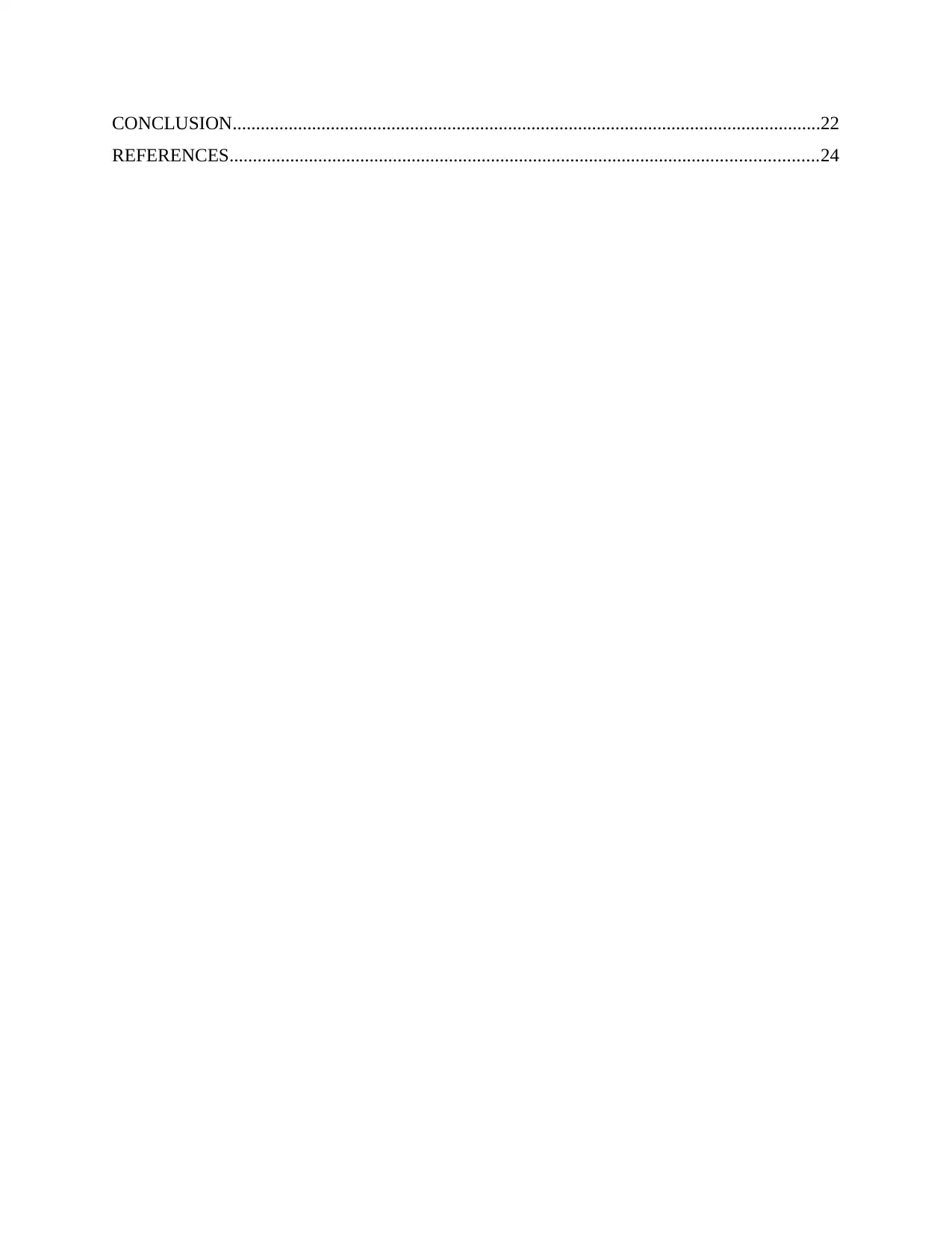
CONCLUSION..............................................................................................................................22
REFERENCES..............................................................................................................................24
REFERENCES..............................................................................................................................24
⊘ This is a preview!⊘
Do you want full access?
Subscribe today to unlock all pages.

Trusted by 1+ million students worldwide
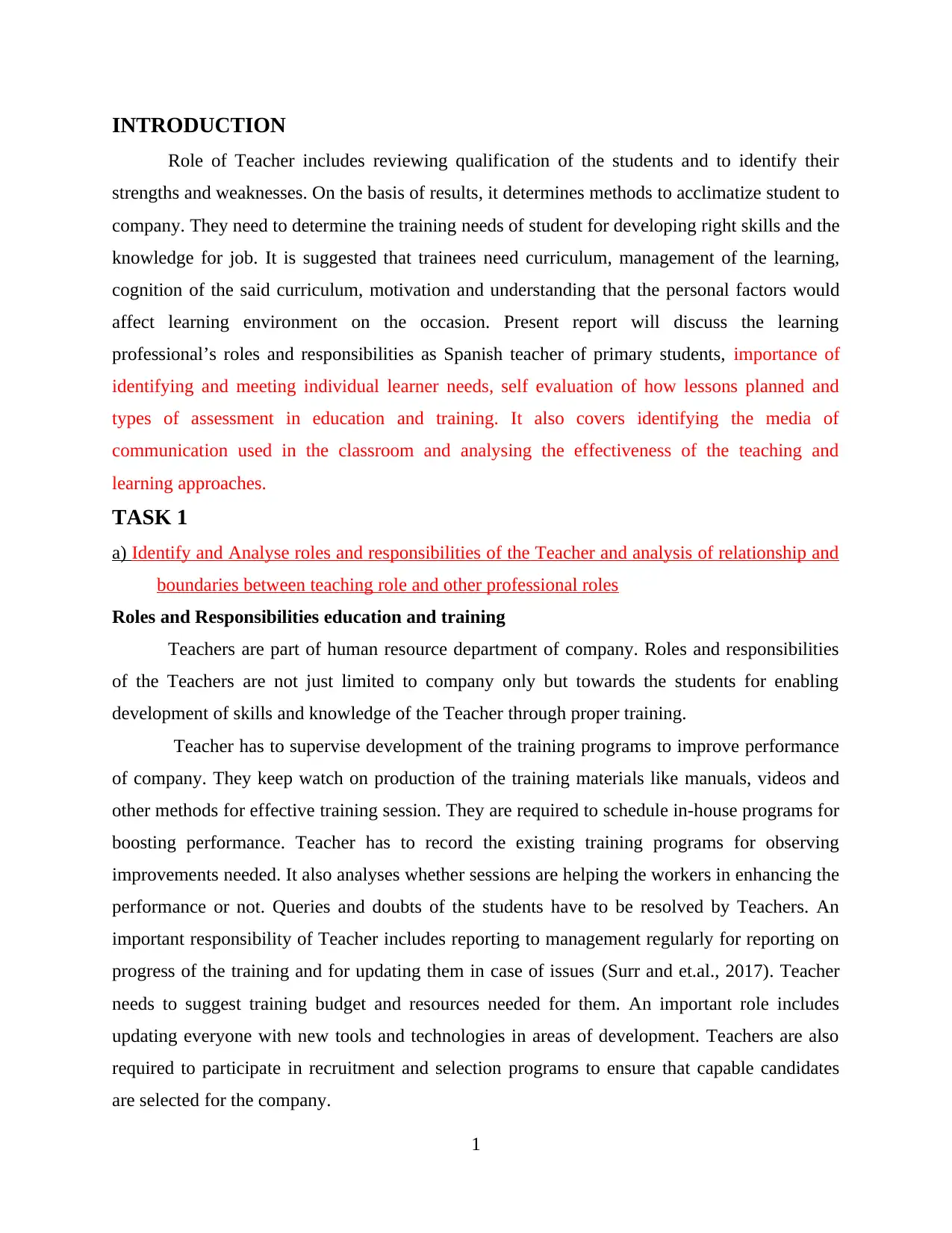
INTRODUCTION
Role of Teacher includes reviewing qualification of the students and to identify their
strengths and weaknesses. On the basis of results, it determines methods to acclimatize student to
company. They need to determine the training needs of student for developing right skills and the
knowledge for job. It is suggested that trainees need curriculum, management of the learning,
cognition of the said curriculum, motivation and understanding that the personal factors would
affect learning environment on the occasion. Present report will discuss the learning
professional’s roles and responsibilities as Spanish teacher of primary students, importance of
identifying and meeting individual learner needs, self evaluation of how lessons planned and
types of assessment in education and training. It also covers identifying the media of
communication used in the classroom and analysing the effectiveness of the teaching and
learning approaches.
TASK 1
a) Identify and Analyse roles and responsibilities of the Teacher and analysis of relationship and
boundaries between teaching role and other professional roles
Roles and Responsibilities education and training
Teachers are part of human resource department of company. Roles and responsibilities
of the Teachers are not just limited to company only but towards the students for enabling
development of skills and knowledge of the Teacher through proper training.
Teacher has to supervise development of the training programs to improve performance
of company. They keep watch on production of the training materials like manuals, videos and
other methods for effective training session. They are required to schedule in-house programs for
boosting performance. Teacher has to record the existing training programs for observing
improvements needed. It also analyses whether sessions are helping the workers in enhancing the
performance or not. Queries and doubts of the students have to be resolved by Teachers. An
important responsibility of Teacher includes reporting to management regularly for reporting on
progress of the training and for updating them in case of issues (Surr and et.al., 2017). Teacher
needs to suggest training budget and resources needed for them. An important role includes
updating everyone with new tools and technologies in areas of development. Teachers are also
required to participate in recruitment and selection programs to ensure that capable candidates
are selected for the company.
1
Role of Teacher includes reviewing qualification of the students and to identify their
strengths and weaknesses. On the basis of results, it determines methods to acclimatize student to
company. They need to determine the training needs of student for developing right skills and the
knowledge for job. It is suggested that trainees need curriculum, management of the learning,
cognition of the said curriculum, motivation and understanding that the personal factors would
affect learning environment on the occasion. Present report will discuss the learning
professional’s roles and responsibilities as Spanish teacher of primary students, importance of
identifying and meeting individual learner needs, self evaluation of how lessons planned and
types of assessment in education and training. It also covers identifying the media of
communication used in the classroom and analysing the effectiveness of the teaching and
learning approaches.
TASK 1
a) Identify and Analyse roles and responsibilities of the Teacher and analysis of relationship and
boundaries between teaching role and other professional roles
Roles and Responsibilities education and training
Teachers are part of human resource department of company. Roles and responsibilities
of the Teachers are not just limited to company only but towards the students for enabling
development of skills and knowledge of the Teacher through proper training.
Teacher has to supervise development of the training programs to improve performance
of company. They keep watch on production of the training materials like manuals, videos and
other methods for effective training session. They are required to schedule in-house programs for
boosting performance. Teacher has to record the existing training programs for observing
improvements needed. It also analyses whether sessions are helping the workers in enhancing the
performance or not. Queries and doubts of the students have to be resolved by Teachers. An
important responsibility of Teacher includes reporting to management regularly for reporting on
progress of the training and for updating them in case of issues (Surr and et.al., 2017). Teacher
needs to suggest training budget and resources needed for them. An important role includes
updating everyone with new tools and technologies in areas of development. Teachers are also
required to participate in recruitment and selection programs to ensure that capable candidates
are selected for the company.
1
Paraphrase This Document
Need a fresh take? Get an instant paraphrase of this document with our AI Paraphraser
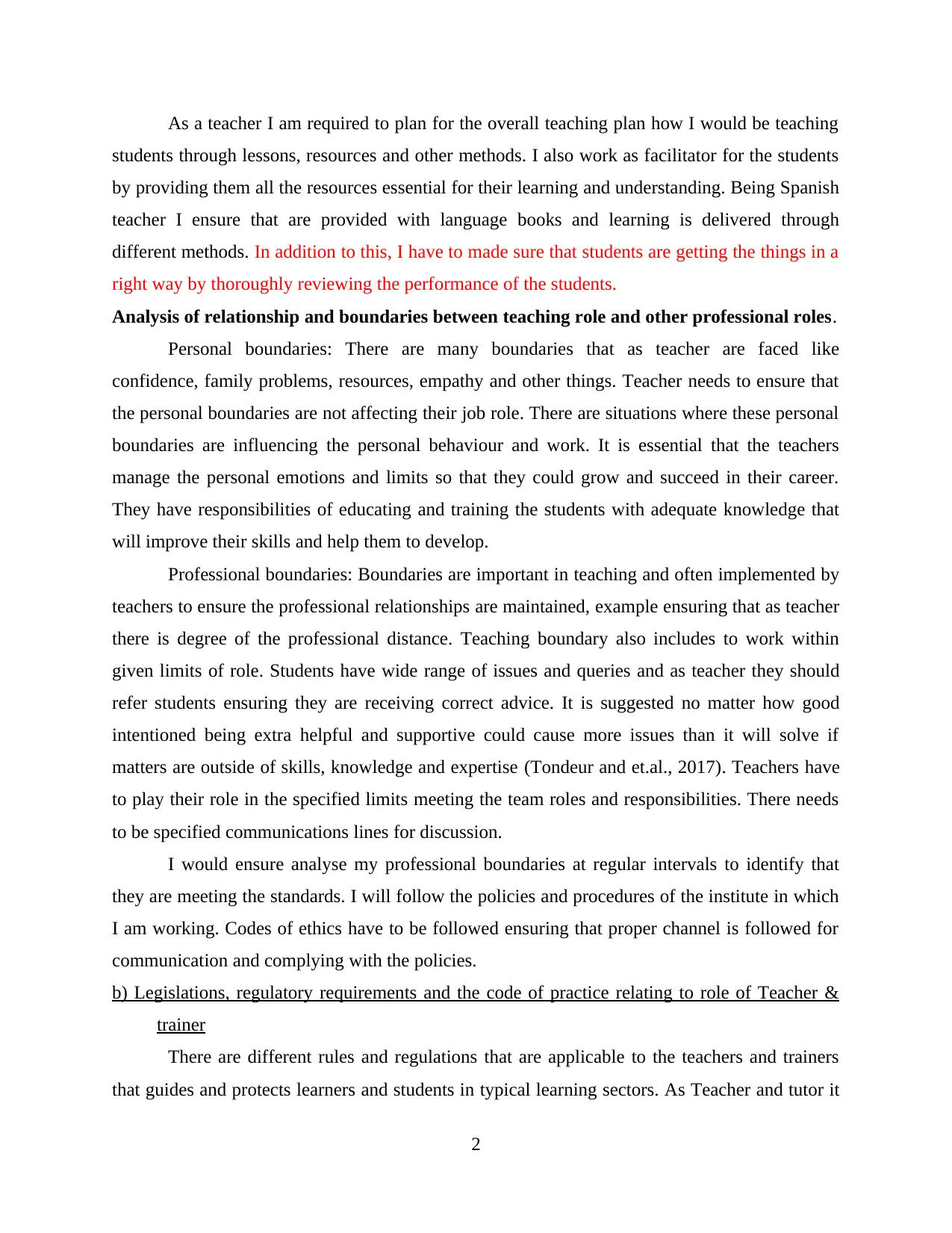
As a teacher I am required to plan for the overall teaching plan how I would be teaching
students through lessons, resources and other methods. I also work as facilitator for the students
by providing them all the resources essential for their learning and understanding. Being Spanish
teacher I ensure that are provided with language books and learning is delivered through
different methods. In addition to this, I have to made sure that students are getting the things in a
right way by thoroughly reviewing the performance of the students.
Analysis of relationship and boundaries between teaching role and other professional roles.
Personal boundaries: There are many boundaries that as teacher are faced like
confidence, family problems, resources, empathy and other things. Teacher needs to ensure that
the personal boundaries are not affecting their job role. There are situations where these personal
boundaries are influencing the personal behaviour and work. It is essential that the teachers
manage the personal emotions and limits so that they could grow and succeed in their career.
They have responsibilities of educating and training the students with adequate knowledge that
will improve their skills and help them to develop.
Professional boundaries: Boundaries are important in teaching and often implemented by
teachers to ensure the professional relationships are maintained, example ensuring that as teacher
there is degree of the professional distance. Teaching boundary also includes to work within
given limits of role. Students have wide range of issues and queries and as teacher they should
refer students ensuring they are receiving correct advice. It is suggested no matter how good
intentioned being extra helpful and supportive could cause more issues than it will solve if
matters are outside of skills, knowledge and expertise (Tondeur and et.al., 2017). Teachers have
to play their role in the specified limits meeting the team roles and responsibilities. There needs
to be specified communications lines for discussion.
I would ensure analyse my professional boundaries at regular intervals to identify that
they are meeting the standards. I will follow the policies and procedures of the institute in which
I am working. Codes of ethics have to be followed ensuring that proper channel is followed for
communication and complying with the policies.
b) Legislations, regulatory requirements and the code of practice relating to role of Teacher &
trainer
There are different rules and regulations that are applicable to the teachers and trainers
that guides and protects learners and students in typical learning sectors. As Teacher and tutor it
2
students through lessons, resources and other methods. I also work as facilitator for the students
by providing them all the resources essential for their learning and understanding. Being Spanish
teacher I ensure that are provided with language books and learning is delivered through
different methods. In addition to this, I have to made sure that students are getting the things in a
right way by thoroughly reviewing the performance of the students.
Analysis of relationship and boundaries between teaching role and other professional roles.
Personal boundaries: There are many boundaries that as teacher are faced like
confidence, family problems, resources, empathy and other things. Teacher needs to ensure that
the personal boundaries are not affecting their job role. There are situations where these personal
boundaries are influencing the personal behaviour and work. It is essential that the teachers
manage the personal emotions and limits so that they could grow and succeed in their career.
They have responsibilities of educating and training the students with adequate knowledge that
will improve their skills and help them to develop.
Professional boundaries: Boundaries are important in teaching and often implemented by
teachers to ensure the professional relationships are maintained, example ensuring that as teacher
there is degree of the professional distance. Teaching boundary also includes to work within
given limits of role. Students have wide range of issues and queries and as teacher they should
refer students ensuring they are receiving correct advice. It is suggested no matter how good
intentioned being extra helpful and supportive could cause more issues than it will solve if
matters are outside of skills, knowledge and expertise (Tondeur and et.al., 2017). Teachers have
to play their role in the specified limits meeting the team roles and responsibilities. There needs
to be specified communications lines for discussion.
I would ensure analyse my professional boundaries at regular intervals to identify that
they are meeting the standards. I will follow the policies and procedures of the institute in which
I am working. Codes of ethics have to be followed ensuring that proper channel is followed for
communication and complying with the policies.
b) Legislations, regulatory requirements and the code of practice relating to role of Teacher &
trainer
There are different rules and regulations that are applicable to the teachers and trainers
that guides and protects learners and students in typical learning sectors. As Teacher and tutor it
2
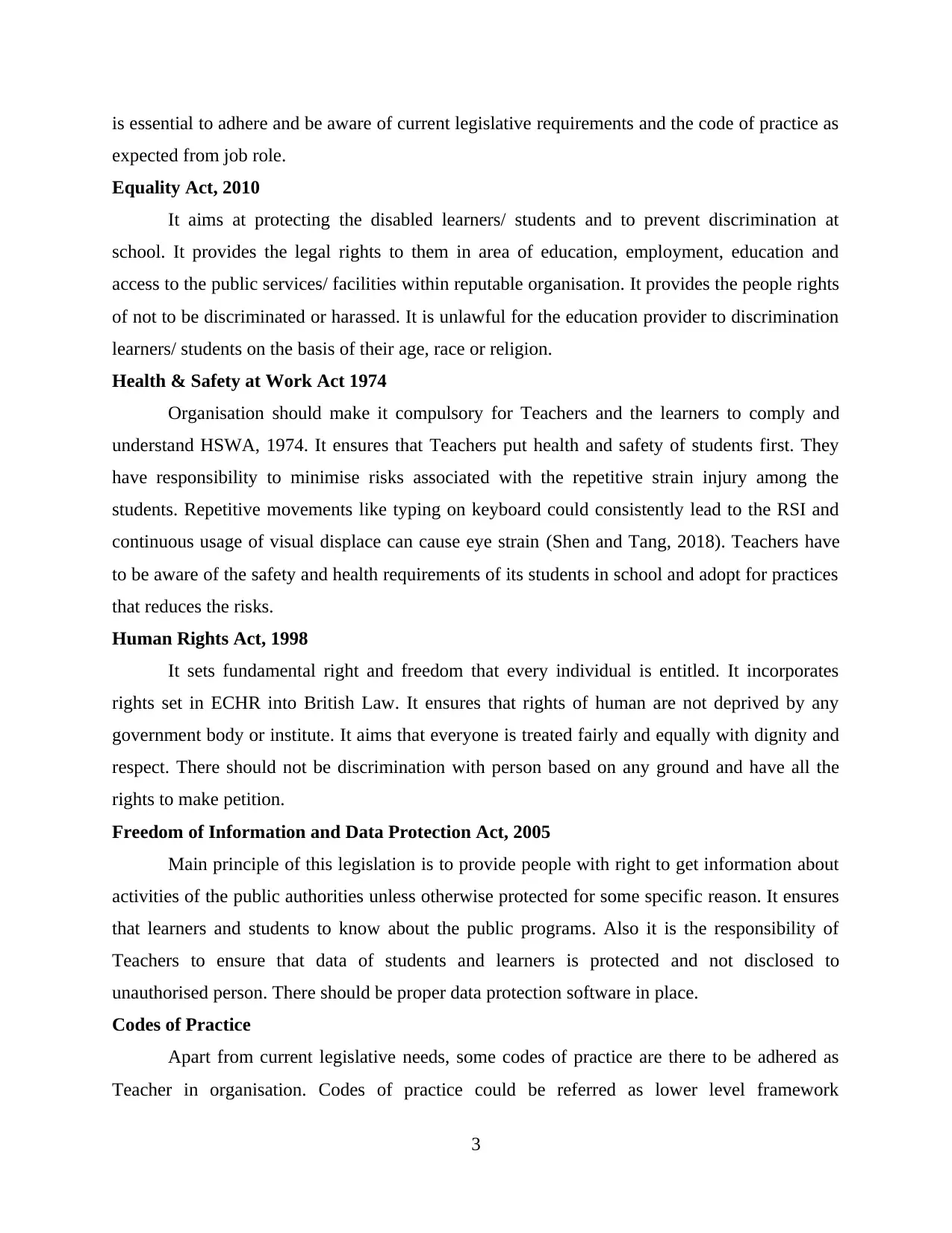
is essential to adhere and be aware of current legislative requirements and the code of practice as
expected from job role.
Equality Act, 2010
It aims at protecting the disabled learners/ students and to prevent discrimination at
school. It provides the legal rights to them in area of education, employment, education and
access to the public services/ facilities within reputable organisation. It provides the people rights
of not to be discriminated or harassed. It is unlawful for the education provider to discrimination
learners/ students on the basis of their age, race or religion.
Health & Safety at Work Act 1974
Organisation should make it compulsory for Teachers and the learners to comply and
understand HSWA, 1974. It ensures that Teachers put health and safety of students first. They
have responsibility to minimise risks associated with the repetitive strain injury among the
students. Repetitive movements like typing on keyboard could consistently lead to the RSI and
continuous usage of visual displace can cause eye strain (Shen and Tang, 2018). Teachers have
to be aware of the safety and health requirements of its students in school and adopt for practices
that reduces the risks.
Human Rights Act, 1998
It sets fundamental right and freedom that every individual is entitled. It incorporates
rights set in ECHR into British Law. It ensures that rights of human are not deprived by any
government body or institute. It aims that everyone is treated fairly and equally with dignity and
respect. There should not be discrimination with person based on any ground and have all the
rights to make petition.
Freedom of Information and Data Protection Act, 2005
Main principle of this legislation is to provide people with right to get information about
activities of the public authorities unless otherwise protected for some specific reason. It ensures
that learners and students to know about the public programs. Also it is the responsibility of
Teachers to ensure that data of students and learners is protected and not disclosed to
unauthorised person. There should be proper data protection software in place.
Codes of Practice
Apart from current legislative needs, some codes of practice are there to be adhered as
Teacher in organisation. Codes of practice could be referred as lower level framework
3
expected from job role.
Equality Act, 2010
It aims at protecting the disabled learners/ students and to prevent discrimination at
school. It provides the legal rights to them in area of education, employment, education and
access to the public services/ facilities within reputable organisation. It provides the people rights
of not to be discriminated or harassed. It is unlawful for the education provider to discrimination
learners/ students on the basis of their age, race or religion.
Health & Safety at Work Act 1974
Organisation should make it compulsory for Teachers and the learners to comply and
understand HSWA, 1974. It ensures that Teachers put health and safety of students first. They
have responsibility to minimise risks associated with the repetitive strain injury among the
students. Repetitive movements like typing on keyboard could consistently lead to the RSI and
continuous usage of visual displace can cause eye strain (Shen and Tang, 2018). Teachers have
to be aware of the safety and health requirements of its students in school and adopt for practices
that reduces the risks.
Human Rights Act, 1998
It sets fundamental right and freedom that every individual is entitled. It incorporates
rights set in ECHR into British Law. It ensures that rights of human are not deprived by any
government body or institute. It aims that everyone is treated fairly and equally with dignity and
respect. There should not be discrimination with person based on any ground and have all the
rights to make petition.
Freedom of Information and Data Protection Act, 2005
Main principle of this legislation is to provide people with right to get information about
activities of the public authorities unless otherwise protected for some specific reason. It ensures
that learners and students to know about the public programs. Also it is the responsibility of
Teachers to ensure that data of students and learners is protected and not disclosed to
unauthorised person. There should be proper data protection software in place.
Codes of Practice
Apart from current legislative needs, some codes of practice are there to be adhered as
Teacher in organisation. Codes of practice could be referred as lower level framework
3
⊘ This is a preview!⊘
Do you want full access?
Subscribe today to unlock all pages.

Trusted by 1+ million students worldwide
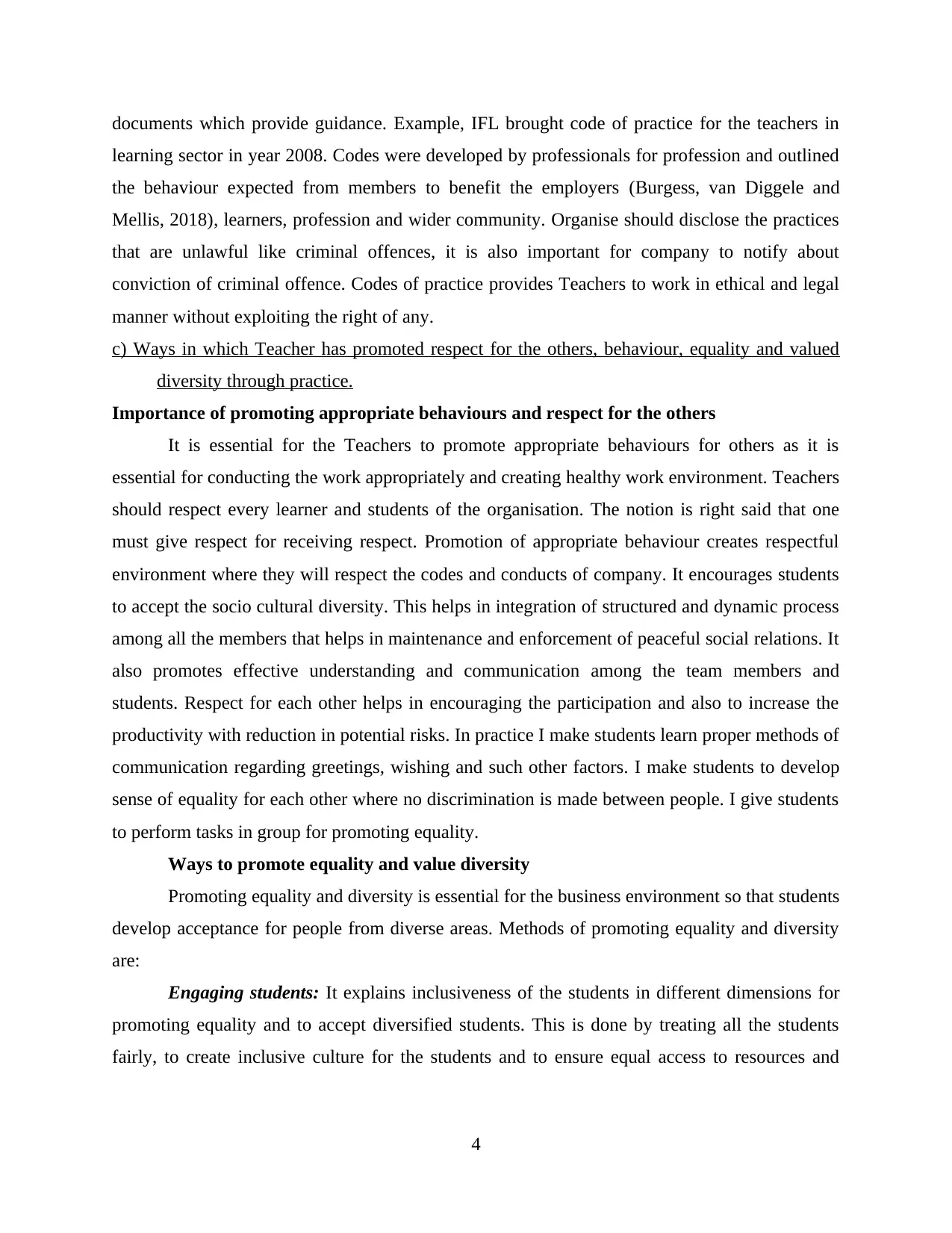
documents which provide guidance. Example, IFL brought code of practice for the teachers in
learning sector in year 2008. Codes were developed by professionals for profession and outlined
the behaviour expected from members to benefit the employers (Burgess, van Diggele and
Mellis, 2018), learners, profession and wider community. Organise should disclose the practices
that are unlawful like criminal offences, it is also important for company to notify about
conviction of criminal offence. Codes of practice provides Teachers to work in ethical and legal
manner without exploiting the right of any.
c) Ways in which Teacher has promoted respect for the others, behaviour, equality and valued
diversity through practice.
Importance of promoting appropriate behaviours and respect for the others
It is essential for the Teachers to promote appropriate behaviours for others as it is
essential for conducting the work appropriately and creating healthy work environment. Teachers
should respect every learner and students of the organisation. The notion is right said that one
must give respect for receiving respect. Promotion of appropriate behaviour creates respectful
environment where they will respect the codes and conducts of company. It encourages students
to accept the socio cultural diversity. This helps in integration of structured and dynamic process
among all the members that helps in maintenance and enforcement of peaceful social relations. It
also promotes effective understanding and communication among the team members and
students. Respect for each other helps in encouraging the participation and also to increase the
productivity with reduction in potential risks. In practice I make students learn proper methods of
communication regarding greetings, wishing and such other factors. I make students to develop
sense of equality for each other where no discrimination is made between people. I give students
to perform tasks in group for promoting equality.
Ways to promote equality and value diversity
Promoting equality and diversity is essential for the business environment so that students
develop acceptance for people from diverse areas. Methods of promoting equality and diversity
are:
Engaging students: It explains inclusiveness of the students in different dimensions for
promoting equality and to accept diversified students. This is done by treating all the students
fairly, to create inclusive culture for the students and to ensure equal access to resources and
4
learning sector in year 2008. Codes were developed by professionals for profession and outlined
the behaviour expected from members to benefit the employers (Burgess, van Diggele and
Mellis, 2018), learners, profession and wider community. Organise should disclose the practices
that are unlawful like criminal offences, it is also important for company to notify about
conviction of criminal offence. Codes of practice provides Teachers to work in ethical and legal
manner without exploiting the right of any.
c) Ways in which Teacher has promoted respect for the others, behaviour, equality and valued
diversity through practice.
Importance of promoting appropriate behaviours and respect for the others
It is essential for the Teachers to promote appropriate behaviours for others as it is
essential for conducting the work appropriately and creating healthy work environment. Teachers
should respect every learner and students of the organisation. The notion is right said that one
must give respect for receiving respect. Promotion of appropriate behaviour creates respectful
environment where they will respect the codes and conducts of company. It encourages students
to accept the socio cultural diversity. This helps in integration of structured and dynamic process
among all the members that helps in maintenance and enforcement of peaceful social relations. It
also promotes effective understanding and communication among the team members and
students. Respect for each other helps in encouraging the participation and also to increase the
productivity with reduction in potential risks. In practice I make students learn proper methods of
communication regarding greetings, wishing and such other factors. I make students to develop
sense of equality for each other where no discrimination is made between people. I give students
to perform tasks in group for promoting equality.
Ways to promote equality and value diversity
Promoting equality and diversity is essential for the business environment so that students
develop acceptance for people from diverse areas. Methods of promoting equality and diversity
are:
Engaging students: It explains inclusiveness of the students in different dimensions for
promoting equality and to accept diversified students. This is done by treating all the students
fairly, to create inclusive culture for the students and to ensure equal access to resources and
4
Paraphrase This Document
Need a fresh take? Get an instant paraphrase of this document with our AI Paraphraser
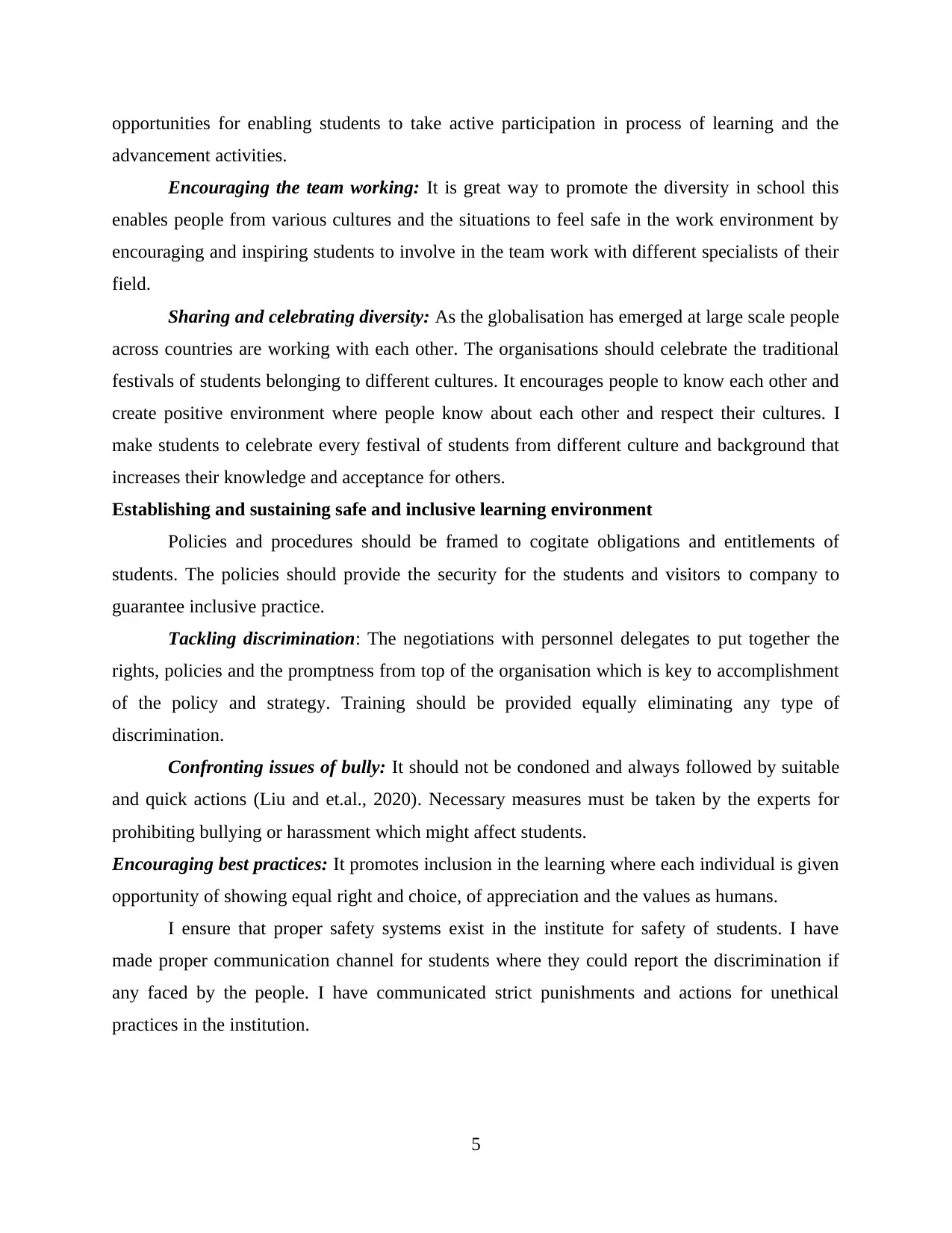
opportunities for enabling students to take active participation in process of learning and the
advancement activities.
Encouraging the team working: It is great way to promote the diversity in school this
enables people from various cultures and the situations to feel safe in the work environment by
encouraging and inspiring students to involve in the team work with different specialists of their
field.
Sharing and celebrating diversity: As the globalisation has emerged at large scale people
across countries are working with each other. The organisations should celebrate the traditional
festivals of students belonging to different cultures. It encourages people to know each other and
create positive environment where people know about each other and respect their cultures. I
make students to celebrate every festival of students from different culture and background that
increases their knowledge and acceptance for others.
Establishing and sustaining safe and inclusive learning environment
Policies and procedures should be framed to cogitate obligations and entitlements of
students. The policies should provide the security for the students and visitors to company to
guarantee inclusive practice.
Tackling discrimination: The negotiations with personnel delegates to put together the
rights, policies and the promptness from top of the organisation which is key to accomplishment
of the policy and strategy. Training should be provided equally eliminating any type of
discrimination.
Confronting issues of bully: It should not be condoned and always followed by suitable
and quick actions (Liu and et.al., 2020). Necessary measures must be taken by the experts for
prohibiting bullying or harassment which might affect students.
Encouraging best practices: It promotes inclusion in the learning where each individual is given
opportunity of showing equal right and choice, of appreciation and the values as humans.
I ensure that proper safety systems exist in the institute for safety of students. I have
made proper communication channel for students where they could report the discrimination if
any faced by the people. I have communicated strict punishments and actions for unethical
practices in the institution.
5
advancement activities.
Encouraging the team working: It is great way to promote the diversity in school this
enables people from various cultures and the situations to feel safe in the work environment by
encouraging and inspiring students to involve in the team work with different specialists of their
field.
Sharing and celebrating diversity: As the globalisation has emerged at large scale people
across countries are working with each other. The organisations should celebrate the traditional
festivals of students belonging to different cultures. It encourages people to know each other and
create positive environment where people know about each other and respect their cultures. I
make students to celebrate every festival of students from different culture and background that
increases their knowledge and acceptance for others.
Establishing and sustaining safe and inclusive learning environment
Policies and procedures should be framed to cogitate obligations and entitlements of
students. The policies should provide the security for the students and visitors to company to
guarantee inclusive practice.
Tackling discrimination: The negotiations with personnel delegates to put together the
rights, policies and the promptness from top of the organisation which is key to accomplishment
of the policy and strategy. Training should be provided equally eliminating any type of
discrimination.
Confronting issues of bully: It should not be condoned and always followed by suitable
and quick actions (Liu and et.al., 2020). Necessary measures must be taken by the experts for
prohibiting bullying or harassment which might affect students.
Encouraging best practices: It promotes inclusion in the learning where each individual is given
opportunity of showing equal right and choice, of appreciation and the values as humans.
I ensure that proper safety systems exist in the institute for safety of students. I have
made proper communication channel for students where they could report the discrimination if
any faced by the people. I have communicated strict punishments and actions for unethical
practices in the institution.
5
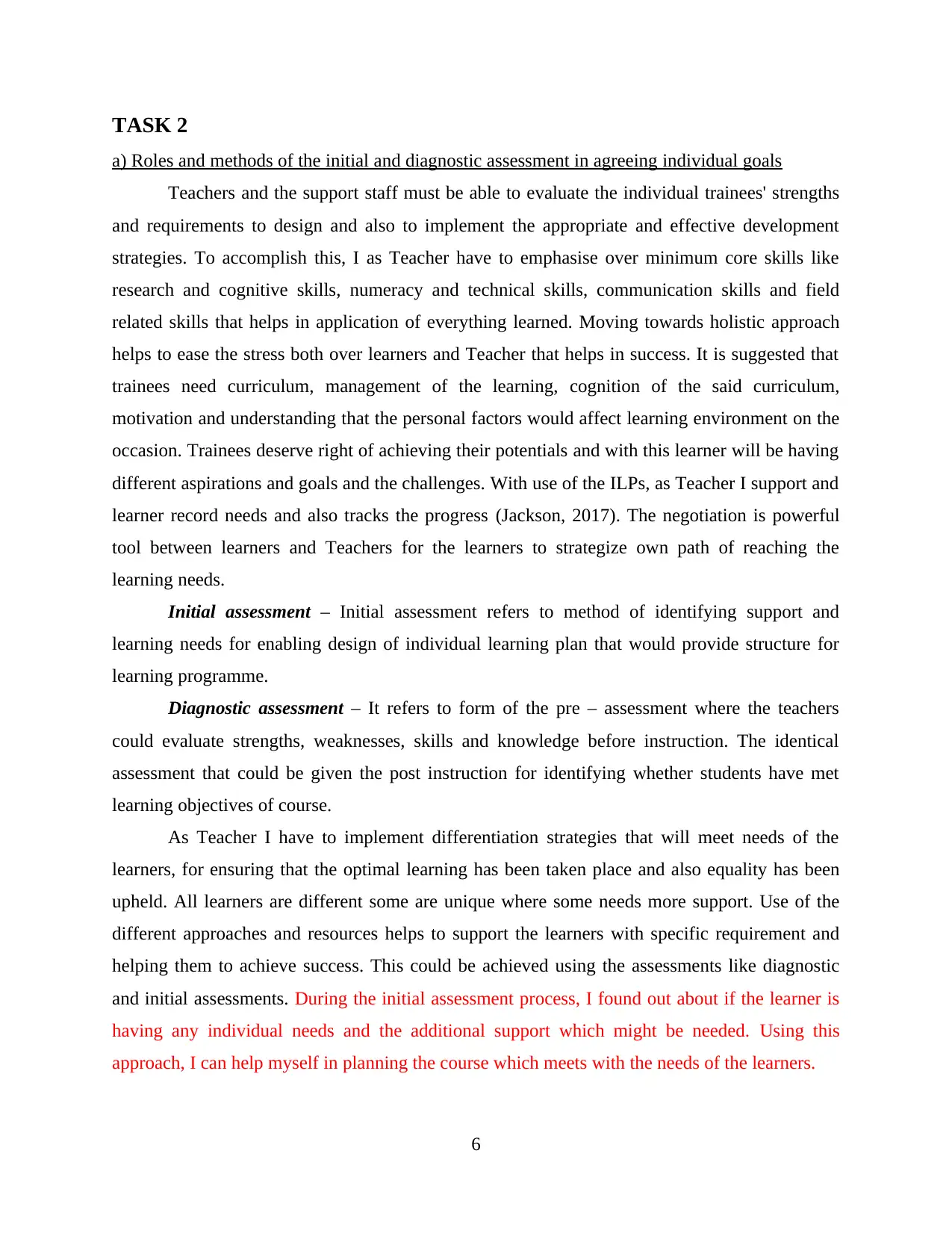
TASK 2
a) Roles and methods of the initial and diagnostic assessment in agreeing individual goals
Teachers and the support staff must be able to evaluate the individual trainees' strengths
and requirements to design and also to implement the appropriate and effective development
strategies. To accomplish this, I as Teacher have to emphasise over minimum core skills like
research and cognitive skills, numeracy and technical skills, communication skills and field
related skills that helps in application of everything learned. Moving towards holistic approach
helps to ease the stress both over learners and Teacher that helps in success. It is suggested that
trainees need curriculum, management of the learning, cognition of the said curriculum,
motivation and understanding that the personal factors would affect learning environment on the
occasion. Trainees deserve right of achieving their potentials and with this learner will be having
different aspirations and goals and the challenges. With use of the ILPs, as Teacher I support and
learner record needs and also tracks the progress (Jackson, 2017). The negotiation is powerful
tool between learners and Teachers for the learners to strategize own path of reaching the
learning needs.
Initial assessment – Initial assessment refers to method of identifying support and
learning needs for enabling design of individual learning plan that would provide structure for
learning programme.
Diagnostic assessment – It refers to form of the pre – assessment where the teachers
could evaluate strengths, weaknesses, skills and knowledge before instruction. The identical
assessment that could be given the post instruction for identifying whether students have met
learning objectives of course.
As Teacher I have to implement differentiation strategies that will meet needs of the
learners, for ensuring that the optimal learning has been taken place and also equality has been
upheld. All learners are different some are unique where some needs more support. Use of the
different approaches and resources helps to support the learners with specific requirement and
helping them to achieve success. This could be achieved using the assessments like diagnostic
and initial assessments. During the initial assessment process, I found out about if the learner is
having any individual needs and the additional support which might be needed. Using this
approach, I can help myself in planning the course which meets with the needs of the learners.
6
a) Roles and methods of the initial and diagnostic assessment in agreeing individual goals
Teachers and the support staff must be able to evaluate the individual trainees' strengths
and requirements to design and also to implement the appropriate and effective development
strategies. To accomplish this, I as Teacher have to emphasise over minimum core skills like
research and cognitive skills, numeracy and technical skills, communication skills and field
related skills that helps in application of everything learned. Moving towards holistic approach
helps to ease the stress both over learners and Teacher that helps in success. It is suggested that
trainees need curriculum, management of the learning, cognition of the said curriculum,
motivation and understanding that the personal factors would affect learning environment on the
occasion. Trainees deserve right of achieving their potentials and with this learner will be having
different aspirations and goals and the challenges. With use of the ILPs, as Teacher I support and
learner record needs and also tracks the progress (Jackson, 2017). The negotiation is powerful
tool between learners and Teachers for the learners to strategize own path of reaching the
learning needs.
Initial assessment – Initial assessment refers to method of identifying support and
learning needs for enabling design of individual learning plan that would provide structure for
learning programme.
Diagnostic assessment – It refers to form of the pre – assessment where the teachers
could evaluate strengths, weaknesses, skills and knowledge before instruction. The identical
assessment that could be given the post instruction for identifying whether students have met
learning objectives of course.
As Teacher I have to implement differentiation strategies that will meet needs of the
learners, for ensuring that the optimal learning has been taken place and also equality has been
upheld. All learners are different some are unique where some needs more support. Use of the
different approaches and resources helps to support the learners with specific requirement and
helping them to achieve success. This could be achieved using the assessments like diagnostic
and initial assessments. During the initial assessment process, I found out about if the learner is
having any individual needs and the additional support which might be needed. Using this
approach, I can help myself in planning the course which meets with the needs of the learners.
6
⊘ This is a preview!⊘
Do you want full access?
Subscribe today to unlock all pages.

Trusted by 1+ million students worldwide
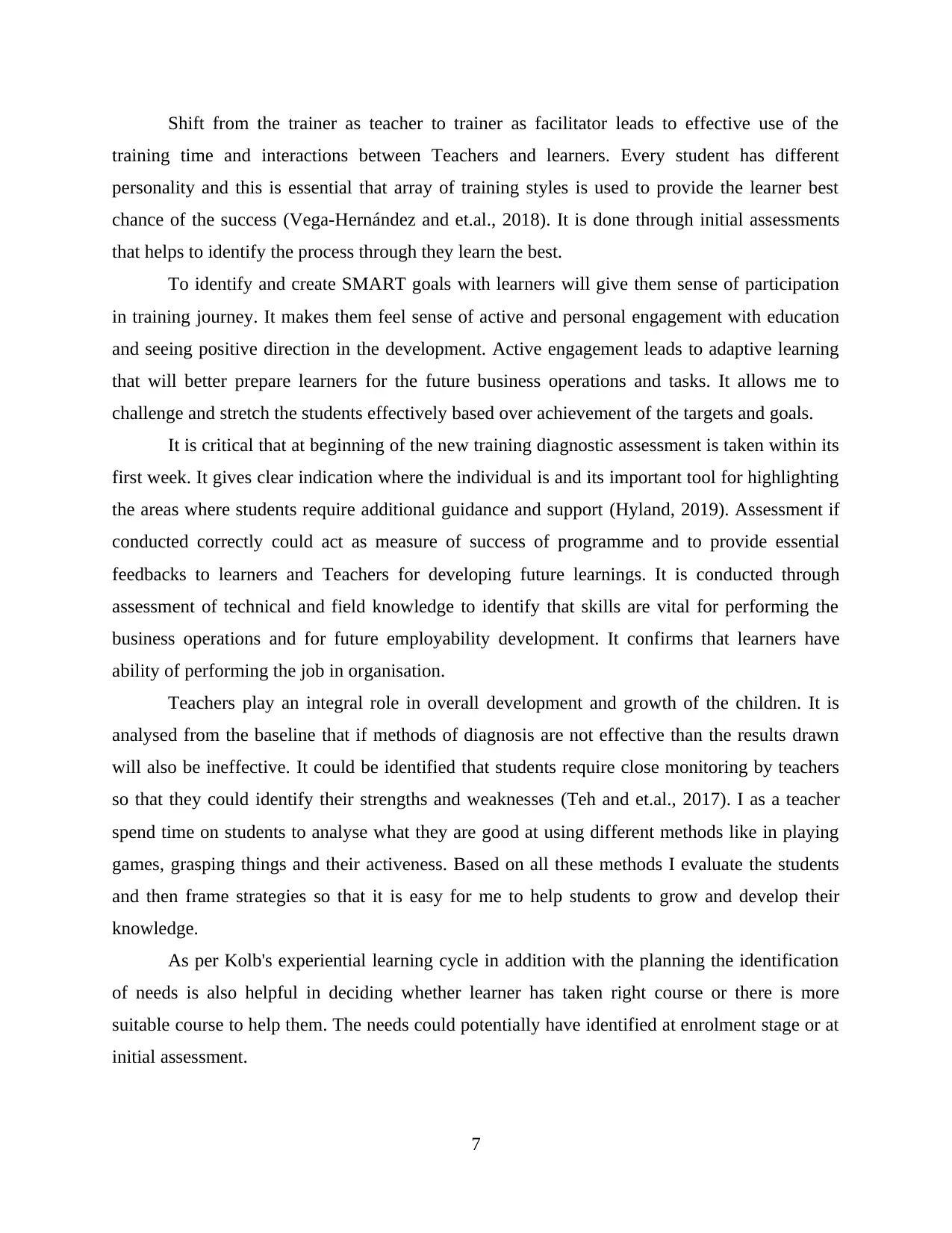
Shift from the trainer as teacher to trainer as facilitator leads to effective use of the
training time and interactions between Teachers and learners. Every student has different
personality and this is essential that array of training styles is used to provide the learner best
chance of the success (Vega-Hernández and et.al., 2018). It is done through initial assessments
that helps to identify the process through they learn the best.
To identify and create SMART goals with learners will give them sense of participation
in training journey. It makes them feel sense of active and personal engagement with education
and seeing positive direction in the development. Active engagement leads to adaptive learning
that will better prepare learners for the future business operations and tasks. It allows me to
challenge and stretch the students effectively based over achievement of the targets and goals.
It is critical that at beginning of the new training diagnostic assessment is taken within its
first week. It gives clear indication where the individual is and its important tool for highlighting
the areas where students require additional guidance and support (Hyland, 2019). Assessment if
conducted correctly could act as measure of success of programme and to provide essential
feedbacks to learners and Teachers for developing future learnings. It is conducted through
assessment of technical and field knowledge to identify that skills are vital for performing the
business operations and for future employability development. It confirms that learners have
ability of performing the job in organisation.
Teachers play an integral role in overall development and growth of the children. It is
analysed from the baseline that if methods of diagnosis are not effective than the results drawn
will also be ineffective. It could be identified that students require close monitoring by teachers
so that they could identify their strengths and weaknesses (Teh and et.al., 2017). I as a teacher
spend time on students to analyse what they are good at using different methods like in playing
games, grasping things and their activeness. Based on all these methods I evaluate the students
and then frame strategies so that it is easy for me to help students to grow and develop their
knowledge.
As per Kolb's experiential learning cycle in addition with the planning the identification
of needs is also helpful in deciding whether learner has taken right course or there is more
suitable course to help them. The needs could potentially have identified at enrolment stage or at
initial assessment.
7
training time and interactions between Teachers and learners. Every student has different
personality and this is essential that array of training styles is used to provide the learner best
chance of the success (Vega-Hernández and et.al., 2018). It is done through initial assessments
that helps to identify the process through they learn the best.
To identify and create SMART goals with learners will give them sense of participation
in training journey. It makes them feel sense of active and personal engagement with education
and seeing positive direction in the development. Active engagement leads to adaptive learning
that will better prepare learners for the future business operations and tasks. It allows me to
challenge and stretch the students effectively based over achievement of the targets and goals.
It is critical that at beginning of the new training diagnostic assessment is taken within its
first week. It gives clear indication where the individual is and its important tool for highlighting
the areas where students require additional guidance and support (Hyland, 2019). Assessment if
conducted correctly could act as measure of success of programme and to provide essential
feedbacks to learners and Teachers for developing future learnings. It is conducted through
assessment of technical and field knowledge to identify that skills are vital for performing the
business operations and for future employability development. It confirms that learners have
ability of performing the job in organisation.
Teachers play an integral role in overall development and growth of the children. It is
analysed from the baseline that if methods of diagnosis are not effective than the results drawn
will also be ineffective. It could be identified that students require close monitoring by teachers
so that they could identify their strengths and weaknesses (Teh and et.al., 2017). I as a teacher
spend time on students to analyse what they are good at using different methods like in playing
games, grasping things and their activeness. Based on all these methods I evaluate the students
and then frame strategies so that it is easy for me to help students to grow and develop their
knowledge.
As per Kolb's experiential learning cycle in addition with the planning the identification
of needs is also helpful in deciding whether learner has taken right course or there is more
suitable course to help them. The needs could potentially have identified at enrolment stage or at
initial assessment.
7
Paraphrase This Document
Need a fresh take? Get an instant paraphrase of this document with our AI Paraphraser
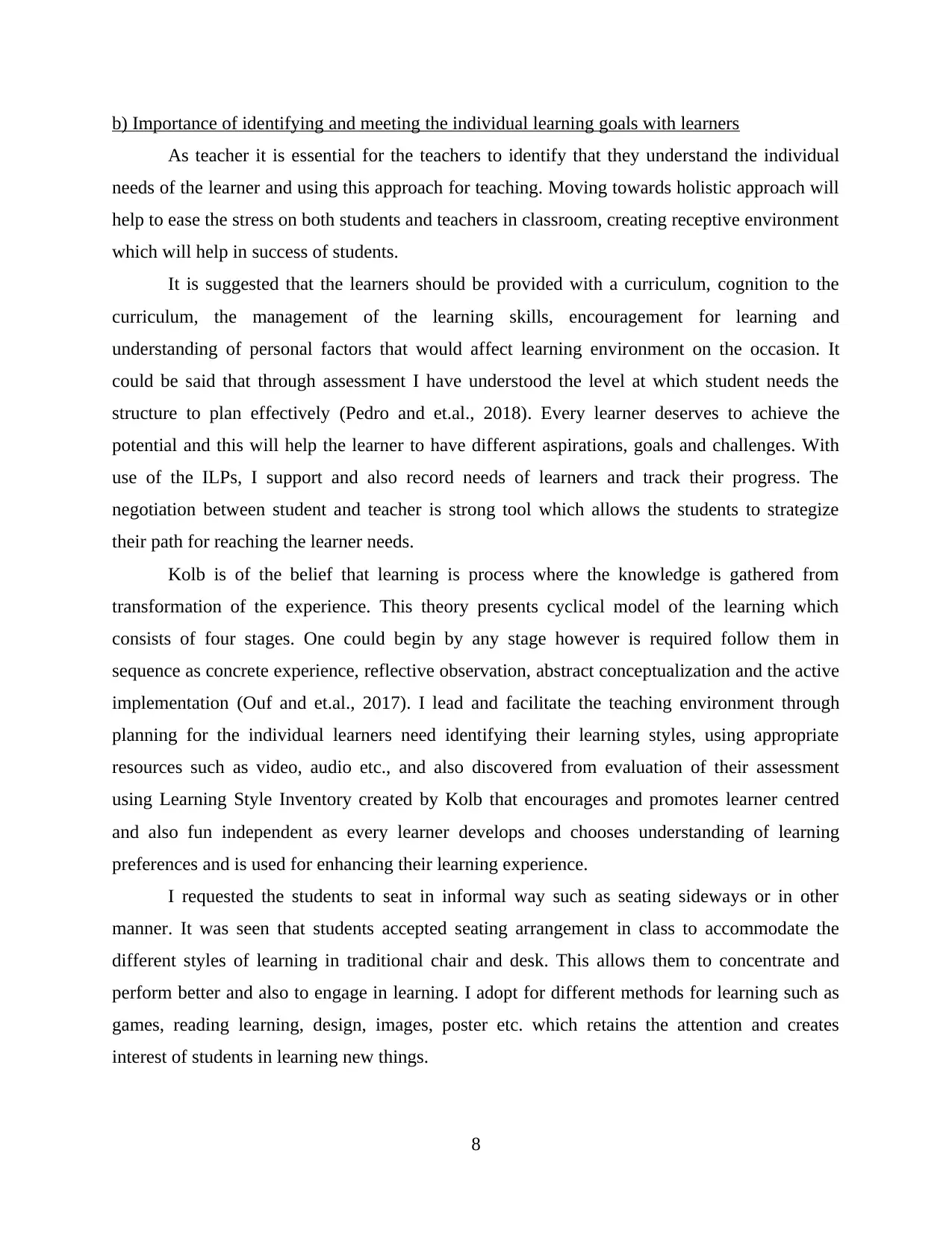
b) Importance of identifying and meeting the individual learning goals with learners
As teacher it is essential for the teachers to identify that they understand the individual
needs of the learner and using this approach for teaching. Moving towards holistic approach will
help to ease the stress on both students and teachers in classroom, creating receptive environment
which will help in success of students.
It is suggested that the learners should be provided with a curriculum, cognition to the
curriculum, the management of the learning skills, encouragement for learning and
understanding of personal factors that would affect learning environment on the occasion. It
could be said that through assessment I have understood the level at which student needs the
structure to plan effectively (Pedro and et.al., 2018). Every learner deserves to achieve the
potential and this will help the learner to have different aspirations, goals and challenges. With
use of the ILPs, I support and also record needs of learners and track their progress. The
negotiation between student and teacher is strong tool which allows the students to strategize
their path for reaching the learner needs.
Kolb is of the belief that learning is process where the knowledge is gathered from
transformation of the experience. This theory presents cyclical model of the learning which
consists of four stages. One could begin by any stage however is required follow them in
sequence as concrete experience, reflective observation, abstract conceptualization and the active
implementation (Ouf and et.al., 2017). I lead and facilitate the teaching environment through
planning for the individual learners need identifying their learning styles, using appropriate
resources such as video, audio etc., and also discovered from evaluation of their assessment
using Learning Style Inventory created by Kolb that encourages and promotes learner centred
and also fun independent as every learner develops and chooses understanding of learning
preferences and is used for enhancing their learning experience.
I requested the students to seat in informal way such as seating sideways or in other
manner. It was seen that students accepted seating arrangement in class to accommodate the
different styles of learning in traditional chair and desk. This allows them to concentrate and
perform better and also to engage in learning. I adopt for different methods for learning such as
games, reading learning, design, images, poster etc. which retains the attention and creates
interest of students in learning new things.
8
As teacher it is essential for the teachers to identify that they understand the individual
needs of the learner and using this approach for teaching. Moving towards holistic approach will
help to ease the stress on both students and teachers in classroom, creating receptive environment
which will help in success of students.
It is suggested that the learners should be provided with a curriculum, cognition to the
curriculum, the management of the learning skills, encouragement for learning and
understanding of personal factors that would affect learning environment on the occasion. It
could be said that through assessment I have understood the level at which student needs the
structure to plan effectively (Pedro and et.al., 2018). Every learner deserves to achieve the
potential and this will help the learner to have different aspirations, goals and challenges. With
use of the ILPs, I support and also record needs of learners and track their progress. The
negotiation between student and teacher is strong tool which allows the students to strategize
their path for reaching the learner needs.
Kolb is of the belief that learning is process where the knowledge is gathered from
transformation of the experience. This theory presents cyclical model of the learning which
consists of four stages. One could begin by any stage however is required follow them in
sequence as concrete experience, reflective observation, abstract conceptualization and the active
implementation (Ouf and et.al., 2017). I lead and facilitate the teaching environment through
planning for the individual learners need identifying their learning styles, using appropriate
resources such as video, audio etc., and also discovered from evaluation of their assessment
using Learning Style Inventory created by Kolb that encourages and promotes learner centred
and also fun independent as every learner develops and chooses understanding of learning
preferences and is used for enhancing their learning experience.
I requested the students to seat in informal way such as seating sideways or in other
manner. It was seen that students accepted seating arrangement in class to accommodate the
different styles of learning in traditional chair and desk. This allows them to concentrate and
perform better and also to engage in learning. I adopt for different methods for learning such as
games, reading learning, design, images, poster etc. which retains the attention and creates
interest of students in learning new things.
8
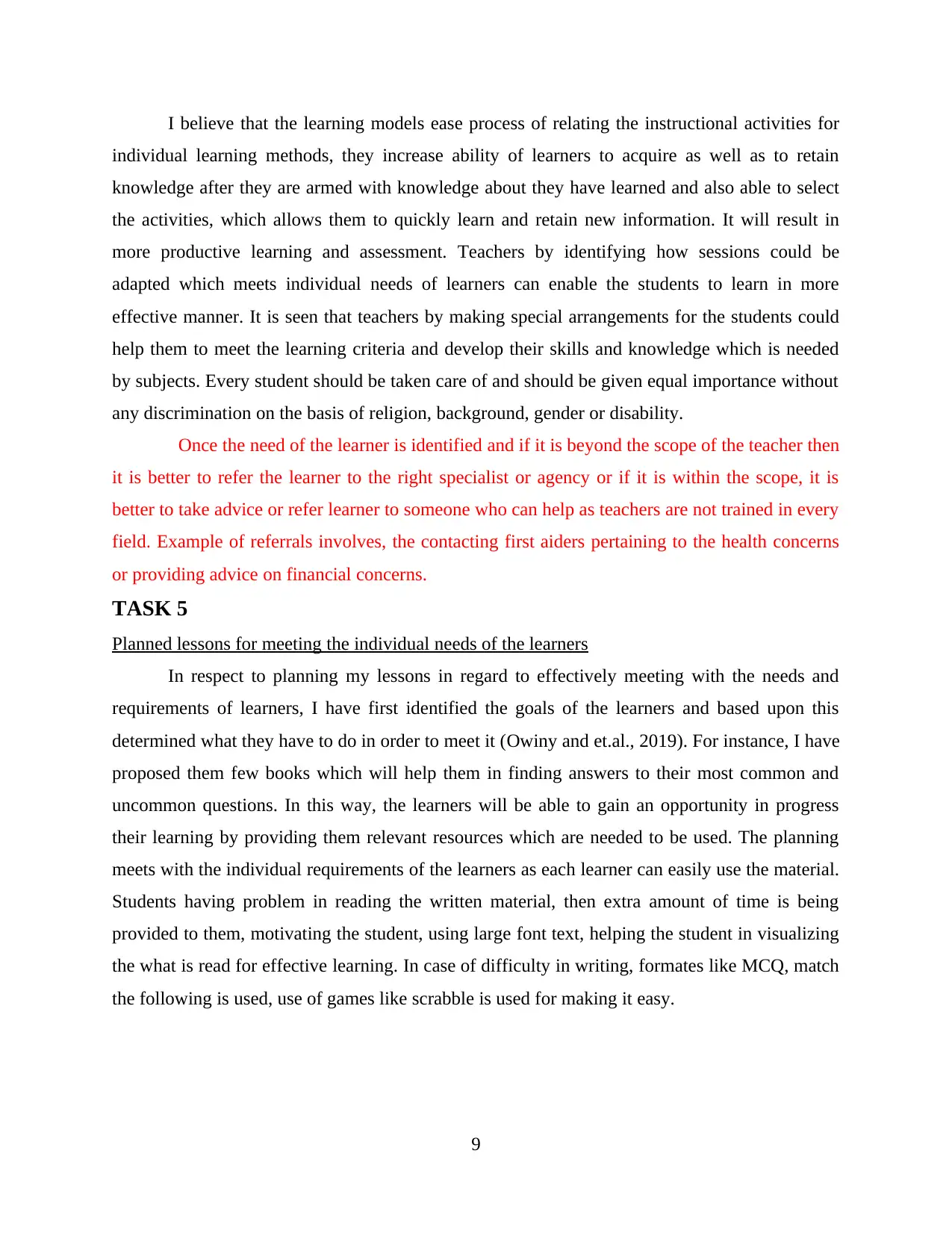
I believe that the learning models ease process of relating the instructional activities for
individual learning methods, they increase ability of learners to acquire as well as to retain
knowledge after they are armed with knowledge about they have learned and also able to select
the activities, which allows them to quickly learn and retain new information. It will result in
more productive learning and assessment. Teachers by identifying how sessions could be
adapted which meets individual needs of learners can enable the students to learn in more
effective manner. It is seen that teachers by making special arrangements for the students could
help them to meet the learning criteria and develop their skills and knowledge which is needed
by subjects. Every student should be taken care of and should be given equal importance without
any discrimination on the basis of religion, background, gender or disability.
Once the need of the learner is identified and if it is beyond the scope of the teacher then
it is better to refer the learner to the right specialist or agency or if it is within the scope, it is
better to take advice or refer learner to someone who can help as teachers are not trained in every
field. Example of referrals involves, the contacting first aiders pertaining to the health concerns
or providing advice on financial concerns.
TASK 5
Planned lessons for meeting the individual needs of the learners
In respect to planning my lessons in regard to effectively meeting with the needs and
requirements of learners, I have first identified the goals of the learners and based upon this
determined what they have to do in order to meet it (Owiny and et.al., 2019). For instance, I have
proposed them few books which will help them in finding answers to their most common and
uncommon questions. In this way, the learners will be able to gain an opportunity in progress
their learning by providing them relevant resources which are needed to be used. The planning
meets with the individual requirements of the learners as each learner can easily use the material.
Students having problem in reading the written material, then extra amount of time is being
provided to them, motivating the student, using large font text, helping the student in visualizing
the what is read for effective learning. In case of difficulty in writing, formates like MCQ, match
the following is used, use of games like scrabble is used for making it easy.
9
individual learning methods, they increase ability of learners to acquire as well as to retain
knowledge after they are armed with knowledge about they have learned and also able to select
the activities, which allows them to quickly learn and retain new information. It will result in
more productive learning and assessment. Teachers by identifying how sessions could be
adapted which meets individual needs of learners can enable the students to learn in more
effective manner. It is seen that teachers by making special arrangements for the students could
help them to meet the learning criteria and develop their skills and knowledge which is needed
by subjects. Every student should be taken care of and should be given equal importance without
any discrimination on the basis of religion, background, gender or disability.
Once the need of the learner is identified and if it is beyond the scope of the teacher then
it is better to refer the learner to the right specialist or agency or if it is within the scope, it is
better to take advice or refer learner to someone who can help as teachers are not trained in every
field. Example of referrals involves, the contacting first aiders pertaining to the health concerns
or providing advice on financial concerns.
TASK 5
Planned lessons for meeting the individual needs of the learners
In respect to planning my lessons in regard to effectively meeting with the needs and
requirements of learners, I have first identified the goals of the learners and based upon this
determined what they have to do in order to meet it (Owiny and et.al., 2019). For instance, I have
proposed them few books which will help them in finding answers to their most common and
uncommon questions. In this way, the learners will be able to gain an opportunity in progress
their learning by providing them relevant resources which are needed to be used. The planning
meets with the individual requirements of the learners as each learner can easily use the material.
Students having problem in reading the written material, then extra amount of time is being
provided to them, motivating the student, using large font text, helping the student in visualizing
the what is read for effective learning. In case of difficulty in writing, formates like MCQ, match
the following is used, use of games like scrabble is used for making it easy.
9
⊘ This is a preview!⊘
Do you want full access?
Subscribe today to unlock all pages.

Trusted by 1+ million students worldwide
1 out of 28
Related Documents
Your All-in-One AI-Powered Toolkit for Academic Success.
+13062052269
info@desklib.com
Available 24*7 on WhatsApp / Email
![[object Object]](/_next/static/media/star-bottom.7253800d.svg)
Unlock your academic potential
Copyright © 2020–2025 A2Z Services. All Rights Reserved. Developed and managed by ZUCOL.




